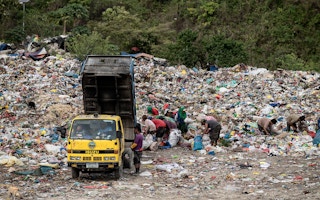City officials of the Philippines’ second most populous metropolis have signed a joint venture with local incinerator company New Sky Energy, Inc (NSEI) for a waste-to-energy facility to be built by 2025.
To continue reading, subscribe to Eco‑Business.
There's something for everyone. We offer a range of subscription plans.
- Access our stories and receive our Insights Weekly newsletter with the free EB Member plan.
- Unlock unlimited access to our content and archive with EB Circle.
- Publish your content with EB Premium.
Under the agreement inked last Thursday, NSEI will invest close to US$82 million to construct the incinerator, and in return, city mayor Mike Rama consented to use the facility and pay a tipping fee higher than the current base fees being paid for using landfills.
This is the first large-scale WTE in the country, after a proposal for a US$423 million facility in Quezon Ciity stalled in 2019, amid strong opposition from environmental groups.
The signing of the joint venture went forward despite protests from green watchdogs Ecowaste Coalition and Health Care Without Harm, which are preparing to contest the legality of the agreement. They argue that it is in violation of the country’s environmental laws such as the Clean Air Act and the Ecological Solid Waste Management Act which ban waste burning.
The groups have also filed a case in the Supreme Court in April and asked the higher Court to intervene and stop the government’s promotion of WTE incinerator facilities.
“Mayor Rama’s agreement with NSEI undermines citizens’ efforts to minimise and reduce their waste, while locking the city into a very long tenure of dirty and expensive waste management system,” said Aileen Lucero, national coordinator of Ecowaste Coalition.
“
The New Sky WTE will not be emitting poisonous and toxic fumes, and will remain compliant at all times with the Clean Air Act and other environmental laws in the country.
Joel Garganera, chairman of the committee on environment, Cebu City
“Incinerators disguised as waste-to-energy facilities remain deleterious to health as they still emit toxic pollutants such as dioxin, lead, and mercury into the environment. The trade-off will always be unjust and inhumane since the health of citizens living near the proposed incinerator facility will be sacrificed, particularly children, the elderly and other vulnerable members of the community,” said Paeng Lopez, programme manager of the Health Care Without Harm.
The city’s daily collection of garbage is about 600 metric tonnes, equivalent to 30 garbage trucks. But the project can convert up to 800 metric tonnes of municipal solid waste into 160 million kilowatts of electricity, enough to power 40,000 households per year, said city councillor Joel Garganera, chairman of the committee on environment.
Garganera argued that there is no total ban on incineration in local laws, contrary to what environmentalists are protesting, saying the only incineration that is banned in the Clean Air Act is that which produces “poisonous and toxic fumes.”
“The New Sky WTE will not be emitting poisonous and toxic fumes, and will remain compliant at all times with the Clean Air Act and other environmental laws in the country,” Garganera told Eco-Business.
He added that the WTE technology also passed the standards of the Department of Science and Technology (DOST) which he said met the limits and measures set by local laws.
“
The committed tipping fee, and the possible commitment of waste volume and pay schemes will result in taxpayers in Cebu paying for the price of this wrong decision, now and in the years to come.
Froilan Grate, executive director, Global Alliance for Incinerator Alternatives (GAIA) Philippines
Meanwhile, Froilan Grate, executive director of anti-waste burning group Global Alliance for Incinerator Alternatives (GAIA) Philippines, debunked Garganera’s claim on the amount of electricity that the facility can provide for households.
He said operators of incinerators in Japan admit that despite the high rate of incineration in metro Tokyo, it has failed to produce a significant amount of energy needed by the city, making it “concerning” that the Cebu CIty officials have based their decision on the energy potential of the project.
“The committed tipping fee, and the possible commitment of waste volume and pay schemes will result in taxpayers in Cebu paying for the price of this wrong decision, now and in the years to come. This is on top of the price they have to pay on their health and the negative impact to the environment, as well as to the livelihood of waste workers and recyclers in the city,” he added.








